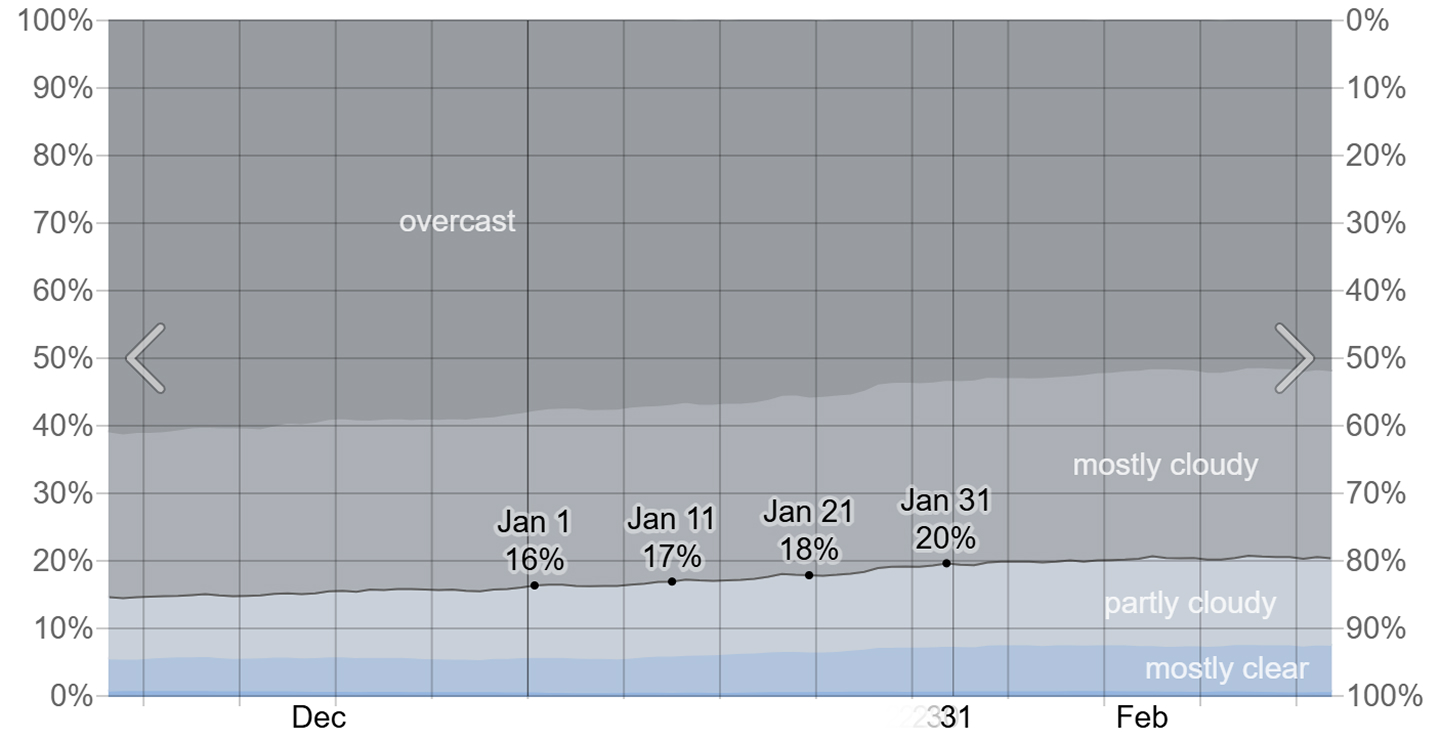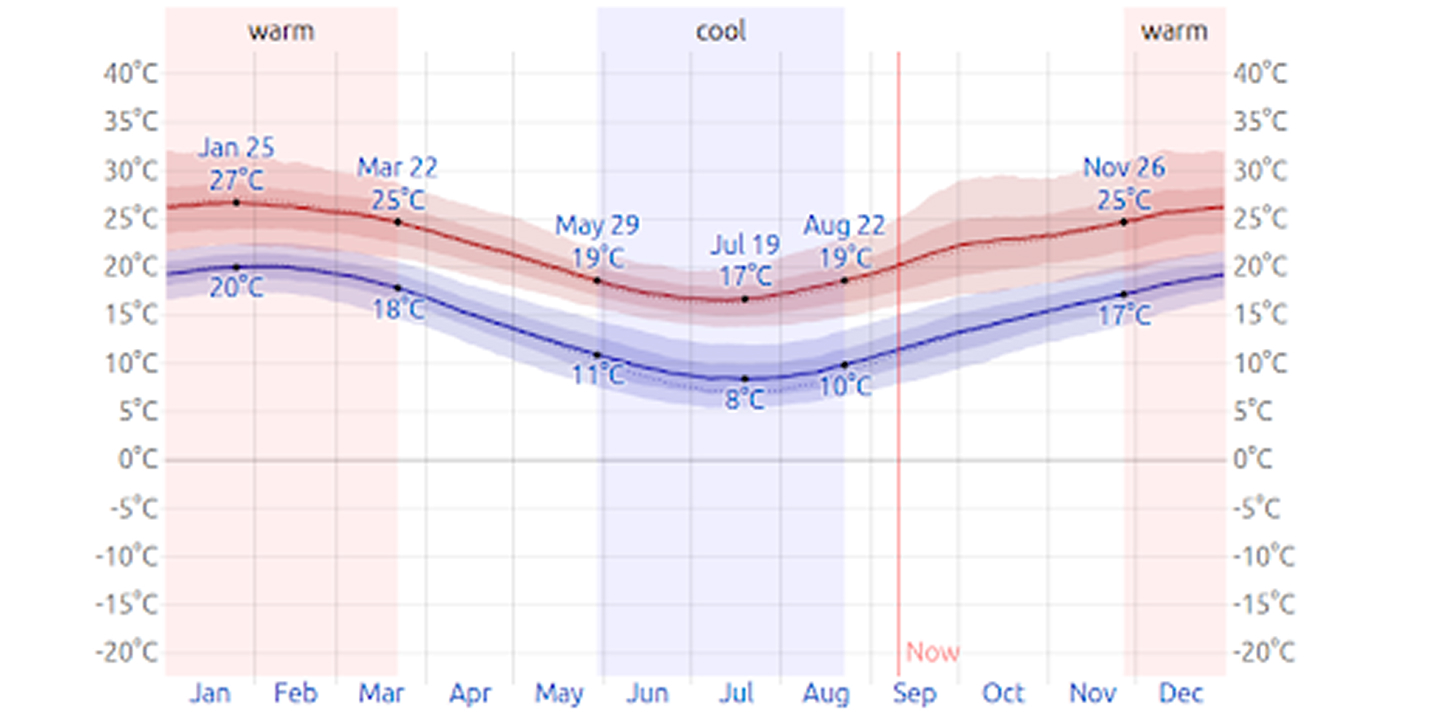0005-Other Eclipses

If observing a solar eclipse in Spain is not within your plans, there are still plenty of opportunities in other parts of the world in the coming years. Below is a selection of notable eclipses on the calendar — the list is not exhaustive, as the paths will touch many more countries.
- 6th of February 2027 - Annular Solar Eclipse - Argentina, Uruguay
- 2nd of August 2027 - Total Solar Eclipse - Egypt
- 26 January 2028 - Annular Solar Eclipse - Brazil
- 22th of July 2028 - Total Solar Eclipse - Australia
- 21th of May 2031 - Annular Solar Eclipse - Angola, Zambia, Tanzania, India, South-East Asia
6 February 2027 – Annular Solar Eclipse in Argentina and Uruguay
South America will welcome its fourth solar eclipse in less than a decade, as the 2027 annular eclipse sweeps across the continent.
February corresponds to late summer in Argentina and Uruguay (the equivalent of August in the northern hemisphere). Warm temperatures, generous sunshine, and minimal rainfall make this period an ideal setting for witnessing the celestial event.
Path of the 2027 Annular eclipse Across Argentina and Uruguay

In Uruguay, coastal towns popular with Montevideo residents for summer getaways — including Piriápolis, Punta del Este, Maldonado, José Ignacio, La Paloma, and Punta del Diablo — will all lie within the path of annularity, ensuring lively gatherings of eclipse watchers.
Although the eclipse path does not pass directly over Buenos Aires or Montevideo, it will come very close, offering excellent partial views.
“Hotels or Homes – Find Your Perfect Stay
with Booking & Airbnb Style Options!”
Clouds and climate in Argentina
For comparison:
On 1 June, the cloudiest day of the year, the likelihood of mostly cloudy or overcast skies is 57%.



Clouds and climate in Uruguay
Traffic and Travel in Argentina and Uruguay During the 2027 annular Solar Eclipse
Given the timing — summer holiday season and a weekend — large numbers of people are expected to travel to the coast. However, as many visitors will depart on Friday and disperse across numerous towns along the eclipse path, heavy congestion is not anticipated to overwhelm the road network. Many travelers will also remain for the entire weekend, easing pressure on the return journey.
Best places to watch the 2027 annular solar eclipse in Argentina and Uruguay and
For more information and to buy Spectrum Eclipse Glasses: lentesparaeclipsesolar.com
| City | Start of the Eclipse | Start Total Eclipse | End Total Eclipse | End of eclipse | Sun Altitude at Maximum | Duration Totality | Cloud probability | Average Temperature August |
|---|---|---|---|---|---|---|---|---|
| Tarifa | 9:40:53 | 10:45:08 | 10:49:48 | 10:00:45 | 38.1° | 4m 39s | 14% | 28°C |
| Área recreativa Montera del Torero | 9:41:02 | 10:45:27 | 20:30:29 | 20:32:08 | 38.2° | 4m 15s | 13% | - |
| Sotogrande | 9:41:15 | 10:45:52 | 20:30:29 | 20:32:08 | 38.5° | 4m 08s | 16% | 29°C |
| Parque natural los Alcornocales | 9:41:05 | 10:45:40 | 20:30:29 | 20:32:08 | 38.1° | 3m 51s | 9% | - |
| Estepona | 9:41:26 | 10:46:19 | 20:30:29 | 20:32:08 | 38.6° | 3m 40s | 7% | 30°C |
| Sitio de Calahonda | 9:41:45 | 10:46:56 | 20:30:29 | 20:32:08 | 39.0° | 3m 26s | 13% | 30°C |
| Marbella | 9:41:40 | 10:46:50 | 20:30:29 | 20:32:08 | 38.9° | 3m 18s | 8% | 30°C |
| Cadiz | 9:41:45 | 10:45:22 | 20:30:29 | 20:32:08 | 37.5° | 3m 02s | 13% | 28°C |
| Torremolinos | 9:42:00 | 10:47:38 | 20:30:29 | 20:32:08 | 39.3° | 2m 42s | 12% | 29°C |
| Malaga | 9:42:07 | 10:48:09 | 20:30:29 | 20:32:08 | 39.3° | 1m 53s | 10% | 30°C |
| Jerez de la frontera | 9:40:58 | 10:46:17 | 20:30:29 | 20:32:08 | 37.6° | 1m 40s | 9% | 34°C |
2nd of August 2027 - Total Solar Eclipse in Egypt
Path of the 2027 eclipse Across Egypt
Clouds and climate

⚠️ Heat alert:
Unlike most eclipses, where cloud risk dominates, here the main challenge is temperature. Afternoon highs frequently reach the mid-40s °C, with extremes approaching 50 °C (110–120 °F). In Luxor, historical records show an average of 42 °C on 2 August, with peaks of 46 °C.

Duration of the 2027 Solar Eclipse in Egypt
Outer Edges of the Eclipse Path
- Minya (northern edge): 4 minutes and 7 seconds of totality
- Faris (southern edge): 4 minutes and 25 seconds of totality
Heart of the Eclipse Path
The true spectacle, however, will be found in central Egypt along the Nile Valley. Cities such as El Quseyya, Asyut, Sohag, Qena, and Luxor will all enjoy extended durations of totality, each lasting over six minutes.
The highlight occurs just 53 kilometers southeast of Luxor, where the eclipse will reach its maximum duration: an astonishing 6 minutes and 23 seconds of complete darkness.
Best places to watch the 2027 solar eclipse in Egypt
| City | Start of the Eclipse | Start Total Eclipse | End Total Eclipse | End of eclipse | Sun Altitude at Maximum | Duration Totality | Cloud probability | Average Temperature August |
|---|---|---|---|---|---|---|---|---|
| Tarifa | 9:40:53 | 10:45:08 | 10:49:48 | 10:00:45 | 38.1° | 4m 39s | 14% | 28°C |
| Área recreativa Montera del Torero | 9:41:02 | 10:45:27 | 20:30:29 | 20:32:08 | 38.2° | 4m 15s | 13% | - |
| Sotogrande | 9:41:15 | 10:45:52 | 20:30:29 | 20:32:08 | 38.5° | 4m 08s | 16% | 29°C |
| Parque natural los Alcornocales | 9:41:05 | 10:45:40 | 20:30:29 | 20:32:08 | 38.1° | 3m 51s | 9% | - |
| Estepona | 9:41:26 | 10:46:19 | 20:30:29 | 20:32:08 | 38.6° | 3m 40s | 7% | 30°C |
| Sitio de Calahonda | 9:41:45 | 10:46:56 | 20:30:29 | 20:32:08 | 39.0° | 3m 26s | 13% | 30°C |
| Marbella | 9:41:40 | 10:46:50 | 20:30:29 | 20:32:08 | 38.9° | 3m 18s | 8% | 30°C |
| Cadiz | 9:41:45 | 10:45:22 | 20:30:29 | 20:32:08 | 37.5° | 3m 02s | 13% | 28°C |
| Torremolinos | 9:42:00 | 10:47:38 | 20:30:29 | 20:32:08 | 39.3° | 2m 42s | 12% | 29°C |
| Malaga | 9:42:07 | 10:48:09 | 20:30:29 | 20:32:08 | 39.3° | 1m 53s | 10% | 30°C |
| Jerez de la frontera | 9:40:58 | 10:46:17 | 20:30:29 | 20:32:08 | 37.6° | 1m 40s | 9% | 34°C |
Buy Spectrum Eclipse Glasses:

26 January 2028 - Annular Solar Eclipse in Brazil
Path of the 2028 annular solar eclipse in Brazil
From Manaus, the shadow of the Moon continues its journey eastward, eventually reaching the Atlantic coast near the border with French Guiana. It is in this remote corner of Brazil that the eclipse will achieve its greatest duration: an astonishing 10 minutes and 27 seconds of annularity. This maximum occurs just 60 kilometers inland from the Atlantic Ocean, in the isolated Uaçá region — a sparsely populated jungle area, largely inaccessible to most travelers.
Clouds and climate


Best places to watch the 2027 solar eclipse in Brazil
22th of July 2028 - Total Solar Eclipse Australia
Path of the 2028 solar eclipse in Australia


Clouds and climate

Best places to watch the 2028 solar eclipse in Australia
Australia in 2028 will thus provide one of the most accessible and memorable total eclipse experiences of the century.
For more information and to buy Spectrum Eclipse Glasses: australiaeclipseglasses.com
| City | Start of the Eclipse | Start Total Eclipse | End Total Eclipse | End of eclipse | Sun Altitude at Maximum | Duration Totality | Cloud probability | Average Temperature August |
|---|---|---|---|---|---|---|---|---|
| Tarifa | 9:40:53 | 10:45:08 | 10:49:48 | 10:00:45 | 38.1° | 4m 39s | 14% | 28°C |
| Área recreativa Montera del Torero | 9:41:02 | 10:45:27 | 20:30:29 | 20:32:08 | 38.2° | 4m 15s | 13% | - |
| Sotogrande | 9:41:15 | 10:45:52 | 20:30:29 | 20:32:08 | 38.5° | 4m 08s | 16% | 29°C |
| Parque natural los Alcornocales | 9:41:05 | 10:45:40 | 20:30:29 | 20:32:08 | 38.1° | 3m 51s | 9% | - |
| Estepona | 9:41:26 | 10:46:19 | 20:30:29 | 20:32:08 | 38.6° | 3m 40s | 7% | 30°C |
| Sitio de Calahonda | 9:41:45 | 10:46:56 | 20:30:29 | 20:32:08 | 39.0° | 3m 26s | 13% | 30°C |
| Marbella | 9:41:40 | 10:46:50 | 20:30:29 | 20:32:08 | 38.9° | 3m 18s | 8% | 30°C |
| Cadiz | 9:41:45 | 10:45:22 | 20:30:29 | 20:32:08 | 37.5° | 3m 02s | 13% | 28°C |
| Torremolinos | 9:42:00 | 10:47:38 | 20:30:29 | 20:32:08 | 39.3° | 2m 42s | 12% | 29°C |
| Malaga | 9:42:07 | 10:48:09 | 20:30:29 | 20:32:08 | 39.3° | 1m 53s | 10% | 30°C |
| Jerez de la frontera | 9:40:58 | 10:46:17 | 20:30:29 | 20:32:08 | 37.6° | 1m 40s | 9% | 34°C |
H1 - 21th of May 2031 - Annular Solar Eclipse
India, Sri Lanka, Malaysia, Indonesia, Thailand
Path of the 2031 annular solar eclipse

- In Angola, maximum annularity occurs just after sunrise, around 6:00.
- In Dar es Salaam and Zanzibar (Tanzania), the “ring of fire” appears around 8:30 in the morning.
- In India, maximum occurs around 13:00.
- At the Thai-Malay border, the peak is at 16:45.
- On the islands of Kalimantan and Sulawesi, maximum annularity occurs slightly later, around 17:04.
Clouds and climate
- Africa: Angola and western Zambia offer some of the best chances for clear skies, with probabilities near 80%. Eastern Zambia averages around 70%.
- Tanzania: As the track approaches the coast, probabilities decline slightly, falling from 70% to around 60%.
- India and Southeast Asia: Unfortunately, conditions worsen considerably. During May, much of this region experiences high cloudiness and pre-monsoon weather. The probability of overcast skies exceeds 80% in many locations, severely reducing the chances of witnessing annularity.
Best places to watch the 2031 annular solar eclipse
For most international eclipse travelers, the Tanzanian coast (Dar es Salaam or Zanzibar) will be the most comfortable and practical base to view the 2031 annular eclipse.
| City | Start of the Eclipse | Start Total Eclipse | End Total Eclipse | End of eclipse | Sun Altitude at Maximum | Duration Totality | Cloud probability | Average Temperature August |
|---|---|---|---|---|---|---|---|---|
| Tarifa | 9:40:53 | 10:45:08 | 10:49:48 | 10:00:45 | 38.1° | 4m 39s | 14% | 28°C |
| Área recreativa Montera del Torero | 9:41:02 | 10:45:27 | 20:30:29 | 20:32:08 | 38.2° | 4m 15s | 13% | - |
| Sotogrande | 9:41:15 | 10:45:52 | 20:30:29 | 20:32:08 | 38.5° | 4m 08s | 16% | 29°C |
| Parque natural los Alcornocales | 9:41:05 | 10:45:40 | 20:30:29 | 20:32:08 | 38.1° | 3m 51s | 9% | - |
| Estepona | 9:41:26 | 10:46:19 | 20:30:29 | 20:32:08 | 38.6° | 3m 40s | 7% | 30°C |
| Sitio de Calahonda | 9:41:45 | 10:46:56 | 20:30:29 | 20:32:08 | 39.0° | 3m 26s | 13% | 30°C |
| Marbella | 9:41:40 | 10:46:50 | 20:30:29 | 20:32:08 | 38.9° | 3m 18s | 8% | 30°C |
| Cadiz | 9:41:45 | 10:45:22 | 20:30:29 | 20:32:08 | 37.5° | 3m 02s | 13% | 28°C |
| Torremolinos | 9:42:00 | 10:47:38 | 20:30:29 | 20:32:08 | 39.3° | 2m 42s | 12% | 29°C |
| Malaga | 9:42:07 | 10:48:09 | 20:30:29 | 20:32:08 | 39.3° | 1m 53s | 10% | 30°C |
| Jerez de la frontera | 9:40:58 | 10:46:17 | 20:30:29 | 20:32:08 | 37.6° | 1m 40s | 9% | 34°C |
